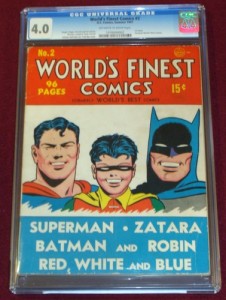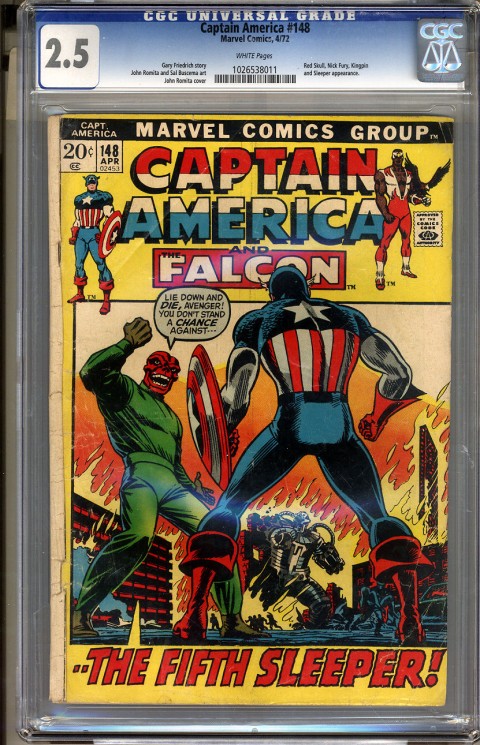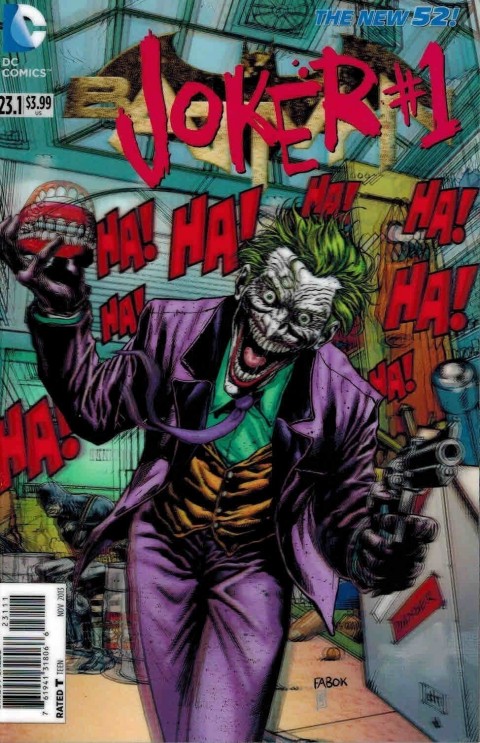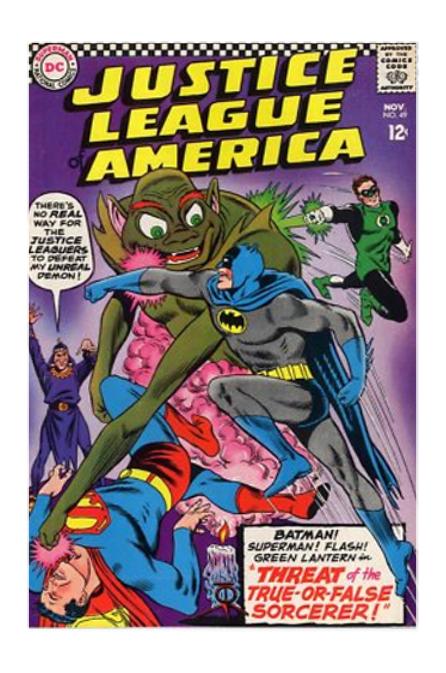For the average comics collector, prices on the most sought after books and even some of the more common fare are getting way out of sight.
There’s no way most can compete with high-end speculators, collectors and investors with more money than they know what to do with and pay thousands and even ten of thousands of dollars for some books.
As a collector for more than 40 years, it’s got to the point that whenever I walk into a comics store – or check out eBay – I have the same problem. What I want I can’t afford and what I can afford I don’t want.
That is why I’m glad to see a recent surge in demand and sales of mid-grade books, primarily F -VF, in the comics market as reported by dealers in the 43rd edition of the Overstreet Price Guide (OPG) and from what I can see on eBay.
In the OPG’s 2013 Market Report, Robert Overstreet says, “We should be mindful that our hobby will continue to prosper only so long as older comic books are within reasonable striking distance of the average collector.”
He followed by saying the OPG tries to reflect market changes, but does so conservatively to help keep the market stable. Sure, some prices are listed too high, others a little too low in the guide, but overall the OPG has helped to keep sanity in the market.
Personally, I think that “striking distance” is already too far away on higher-grade comics classics, but some good deals are available for those that aren’t frothing at the mouth in a rabid fit for Near Mint.
Of course, overpricing of newly-minted “hot” books and variants pulled off the shelves and graded by CGC the same day isn’t helping to keep sanity in the market. But don’t blame the grading companies for most of that. They grade the book for the customer; they don’t set the ridiculous prices many speculators, dealers and other sellers want to get.

However, judging from experience in buying books for the past 30 years, I’ve found that lower-grade books still don’t sell well unless they are “key” books priced at less than the Overstreet listing. Of course, Overstreet also overprices some books; particularly common material printed since the 1980s when it lists cover price for some I see sit unsold in dollar bins at local comic shops or on eBay.
Sooner or later, collectors like me have to settle for purchasing lower-grade treasures we want – if we want to have them at all.
In my collection, I have an almost complete 6.0 to 9.4 run of Batman from No. 136 to No. 260, my era of focus, as well as Detective 359 to 420. Most are between 6.0 and 8.0 and that’s fine with me; I’ll not pay ridiculous prices for a 9.4. My limit is $500 for any book and I’ll pay that much only if it’s an exceptional deal and there is a good chance of getting my money back.
Everyone wants a 9.4 or better copy . So do I, That’s something that will never change. The higher-grade books will always be worth more and I understand that. However I also understand the comics market needs a dose of reality; particularly at the high end.
I would like to see better prices, better sales and more respect for lower-grade books and a return of the market to those that love comics for the stories and the art without the negative influence of the high-end speculation.
Classic comics are antique treasures and should be worth some money, but I really think it’s getting out of hand – $1,000 for Walking Dead No. 1? I can’t wait to see the TV show canceled and that book drop like a rock.
Back to my point, there is just too much of a pricing spread between an 8.0 and a 9.4 or above and I suspect it is artificial.
To me, there’s nothing significantly different between an 8.0 and a 9.4 that could demand such a dramatic hike in price except among people that have more dollars than sense.
That bubble is going to burst someday and, personally, I don’t think that will be such a bad thing.
There are a lot of classic comics out there that are good buys if collectors will be patient and search for them and don’t feel like they have to have perfection. Help bring some sanity to the market by refusing to overpay; particularly for manufactured “collectibles” such as variant covers, death sagas and the latest movie or TV-inspired faux classics.





I am so glad you wrote this article. As a person with limited means, I always bargain hunt for those key issues where on ebay I find are sold 20%-50% more than what I find at the local comic shops and sometimes shows. Personally to me if a key issue is 8.0 I’ll pick that up before a 9.4 just because of the price difference.
You’re article is very encouraging. I picked up an Amazing Spider-Man #42 that was in rough shape: there were so many folds and creases that you’d think they were Spidey’s own webbing defacing the cover. Otherwise it was pretty intact. I was willing to spend some money on a copy in Fine condition, but since that was all that was available, and it was on sale for $12, I figured it was a good deal. It is funny: when I read the Overstreet reports from dealers, it’s hard for me to join in on their excitement for comics that sell in the tens and hundreds of thousands of dollars. I much prefer to read the reports by collectors who stand up to the ridiculous values being banded by those same dealers.
Tom, I hear what you’re saying but I’m sure you realize it’s all relative. Like any other market or investment, the intention is not to lose money. Sounds obvious and yet lots of people end up doing just that. Most investments are a form of “ponzi” scheme. That is, the winnings come from someone else’s loss.
Once you know how to play the game, $30k for a book is not expensive if you can flip it for $50k or more! Many comic sharks do this on a regular basis (not that I agree with it, ethics aside…). It’s no different then people who flip condos. Buy in at pre-construction and flip after it’s been built for a sweet return for letting your cash sit for a couple of years. In other words, $30k for a book is not so expensive if you can turn it into $50 next year… and it’s better having your cash sit in a bank. Whether the book is $30k or $30, the concept is still the same, so the value of book does not change the action. So people may think an 8.5 is more affordable, but it depends on the purpose. If you don’t plan to ever sell, why not simply settle for a 4.0 and save some cash.
You also have to differentiate between RAW and CGC books. Buy RAW books cheap to build a collection, CGC books are purely for flipping. I know it’s hard but do not fall in love with CGC books…
There are 2 current trends that concern me:
1. Movie hype: I’m reluctant to jump on the movie band wagon, because… If the Guardians of the Galaxy was never really popular before the movie, who’s to say they will be popular after the movie. Sure things can change but we’re talking about a tier 3 group of characters that never resonated with the fans. The rise in books like these are purely due to speculation so I don’t place much value on them. However, this is a new generation and if the movie is good… it could change all this. But, am I willing to place a $1000 bet and buy GOTG 9.2 today? Answer: NO.
2. The rise of the silver age: Silver age keys have been surging lately. Has the economy really recovered? Are the buyers back from their hiatus? Or are the flippers looking at the blue chips after the bronze age collapse. I don’t know… But what I do know is that nothing lasts forever. It amazes me how people defy logic sometimes. When you see a trend that is exponentially curving toward a near vertical slope, it’s a sure sign to get out. Not to say that the investment is bad, but it may be time for a correction. The SA books are not that bad right now but it’s worth keep an eye on.
It all may seem out of hand but no more so then the rest of the world. Not to get philosophical but consider how distribution works, who empowers the government and who the government supports…
My advice to collectors is to buy cheap RAW books for the pure joy of collecting. If you wanna gamble with CGC books, buy only quality books that have potential to rise, NOT what you like. There are many key books out there that are flat, or declining so make sure you track the trend and work the margins. It’s also important to note that investing in modern books is very different then the bronze or silver ages. Golden age varies as well but now we’re getting into nuances…
Good comment Charle. Just like any investment, it’s based on supply and demand. Personally if I am going to just read a comic, i go the digital route. There’s no reason for me to store a 4.0 in my collection. I would rather have the digital version on my Kindle. I also think its better to have a smaller, but better quality collection for investment purposes. Choose you comics wisely! More of a concern for me is the arbitrary numbers the Overstreet guide puts on these comics. How do they arrive at these numbers ? If its based off of the previous edition, how did they arrive at the numbers in the very first edition ? Apparently Overstreet has a monopoly on the comic price guide market. If there was another major price guide out there, competition would bring the comic prices down.
That’s just it Charlie. There is no difference between “raw” and “CGC” books. CGC books are just “Raw” books that have been graded; as if CGC were the only authority on grading. My objection to most of the “flipping” and how much you can get for a book is that’s all the book matters; how much it is worth. There’s just too much focus on “how much a book is worth” that, in my opinion of course, is detrimental to the overall market, particularly to the average collector. Of course, the high-end is not going away. It’s here to stay, but I’d like to see a little more sanity and reality come to fruition and if it takes a market crash, so be it.
Hello Ed, Overstreet is continually updating pricing information from many sources across the country that report what a book is selling for along with minute upward adjustments based on what the market is doing and has done. I do believe there is a lot of manipulation going on. Some prices are definitely listed too high and some too low, but since it only comes out annually, it’s very difficult to keep up with the quick trends going on.
Good assessment, Charlie. I can agree with a lot of that. My collection is primarily Silver Age, but I paid very little for most of them since I’ve had most of them for 40 years. As far at TV and movie trends, I don’t go there unless I just like the story and art.
The difference in price is really just not worth it; most of the time.
There is an article in the new guide you need to read. It’s under the 2013 Market Report written by Lon Webb of Dark Adventures Comics. Too many Overstreet advisors, I believe, are pushing their stock. Not too often do you get a very honest assessment of the market like Mr. Webbs, although it may also contain some questionable information.
I’m not sure I understand. Isn’t Overstreet all about how much a book is worth? Wether you sell or not, CGC or otherwise, Overstreet perpetuates and promotes the perception of value. CGC may not be the only authority, but they are the only recognized authority (although PGX is trying hard to establish themselves as well). The same could be said about Overstreet. Who empowered these guys as the de facto experts of value? I find it odd and contradictory that you can accept Overstreet as a standard but not CGC. Both are equally false (or equally true), both serve the same purpose, both dominate their respective territories and both are based on the perception they’ve built.
If you’ve ever read any of my past comments, I’ve often compared comics to that of the diamond market. Similarly, diamonds are valued based on purity or absence of flaws, colour (white to amber or cream in the comics world), the cut… etc, and certified diamonds costs more. While I agree with you that a comic is a comic, in that diamonds are diamonds, certification does adds value, albeit based perception. However, I would argue that all value is based on perception anyways so I’m not sure what difference any of it makes. Where CGC is concerned, the value lies in that they are a mutually accepted standard. Again, they’re no different then Overstreet. Also, any one who’s tried to buy books online pre CGC can appreciate the value of a third party system.
I guess I’m confused as to what you mean by “too much focus on how much a book is worth”. There are people who read comics for their entertainment value, but the whole back issue market is basically based on people believing that cartoon drawings are worth something. How do you determine how much is too much?
In reality, the only source that Overstreet uses are the advisers. The whole point of being an Overstreet adviser is that they are supposed to submit sales reports. However, no adviser I’ve ever spoken to does this, let alone track their sales. In fact, most adviser don’t even know they’re supposed to report their sales. It’s a lost system. Even if it was functioning, considering how small the market is and how flawed people are, there is no way to validate any of the numbers. It’s also a huge conflict of interest since most advisers are shop owners.
So, the short of it is… the Overstreet numbers are pulled out of thin air. What makes me laugh is, during a recession where all markets struggling, according to Overstreet, the comics market is still in growth mode. Pretty hilarious! But, as I’ve said in my previous comment, the whole world functions this way so it’s difficult to point the finger in one direction. If you’ve ever looking into the housing market and derivatives… if you’ve ever looked into how IPOs are valued… it might as well be David Copperfield in charge of the numbers:
http://pictures.directnews.co.uk/liveimages/David-Copperfield–reveals-he-is-father-to-daughter-in-highchairs–_3741_800701175_0_0_7006695_300.jpg
Hey Charlie,
Lots of good stuff here and I agree with almost everything. I do however completely disagree with one comment. that being that CGC books are only for flipping. I have purchased over 100 CGC books and about 70 of them are still in my collection all opened and in mylar. I buy them at auction and almost all of them are under guide. I initially purchased alot of cheaper books (Marvel Tales,Strange Tales, etc) in different grades to see how CGC grades there books in relation to my local shops. Once I knew that I purchased accordingly. Don’t get me wrong I still get the odd bad apple and occassional pleasent surprise. And I still buy plenty from my local guys. As Tom says CGC and raw books are the same thing. People who get a book CGC’d do so for a myriad of reasons:
It makes their book easier to sell on the internet.
They can have an independent source grade their book.
They know the book is good but are uncertain how good.
As so on….
I also find the variety of books in the 6.0 to 9.0 (where I live) is better.
Having said all that, I feel Tom’s pain as well. Books I want continue to fall out of my financial reach. I went 0 for everything on the last Comiclink auction.
Hey Charlie, I’m primarily focused on the high end and the detrimental effect that part of the market is having on the overall market; just as Overstreet said in his 2013 Market Report introduction and his reasoning behind not listing a book for millions of dollars just because some millionaire is willing to pay that much. As antique treasures, all classic comics are going to be worth some money, but when there is an over-focus on how much a book is worth at the cost of everything else, that’s where I have a problem. Of course this is just my opinions. Everyone is free to have theirs. That’s how it works.
I have about 15 CGC books. They have also been opened and placed in Mylar +. But I got them at bargain prices. Otherwise, I would have let them go into ebay’s Twilight Zone. But the seller finally came down to about 50 percent of what the book is worth graded – less than $30.
Yep, there’s a lot of manipulation and price promoting going on Charlie. That’s why Overstreet is a “guide,” nothing more.
Fair enough Mike but once the CGC case is cracked, it’s no longer a CGC comic. What individuals chose to do with their CGC comic is a personal choice and I think it’s great that you prefer to add them to you collection. However, CGC as a company is a spawn of eBay. Prior to CGC, there was a good chance that you’d receive a 6.0 for the book you just bought online described as a 9.0. This is the main reason that I started buying CGC myself. The CGC boys saw an opportunity and jumped on it. In turn, they’ve inspired auction sites like ComicLink and ComicConnect. Josh Nathanson himself has said that CGC had revolutionized his business. So love it or hate, CGC was established to help facilitate the buying and selling of books.
I’m not sure that “detrimental” is the right word here, and it’s a matter of perspective. I don’t read Overstreet but it sounds like they are talking about tapering the market. Same thing that China is trying to do with their condo market. Governments try to regulate hot markets in order to avoid a crash. However, the collector market is not tied to our economy in a very meaningful way.
The flip side is that the focus on monetary value is what makes the back issue market work, so for Overstreet to say there is an “over-focus” sounds perplexing since the concept of grading is all about dollar value. Otherwise, why not simply settle for a low grade since, as a book, it functions the same as a high grade. When I read your comments saying you’ve got an F or VF… isn’t this simply code for saying that you’ve got a $200 book or whatever that particular book is worth? It’s a form of bragging that all collectors, including myself, engages in. This is why I recommend people collect low grades for personal collections and quality CGC books for flipping. Since you can’t take it with you… I assume both you and Mike hope to cash out someday…
Nice discussion… thanks Tom.
CGC is just like everything else guys, it’s got an upside and a downside.
Charlie – I’ll probably “cash in” and someone else will “cash out”. And I echo your comment, a very good discussion Tom.
Thanks for the comments fellas. Yep, I’ll probably make quite a bit of money on my collection when I sell it, book value is $132,000, but right now I’d have to be dead to let go of one book. LOL.
Thanks! I also like learning about other lesser known titles or issue numbers or storylines that are worth picking up and some of the Overstreet reports do point readers in those road-less-travelled directions.